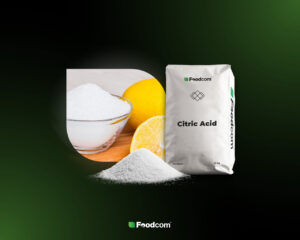- Características y origen: el ácido cítrico (E330) es un compuesto químico natural que se encuentra en la fruta y que también se utiliza en forma sintética.
- Propiedades: reduce el pH, prolonga la vida útil de los productos, tiene efectos blanqueadores y exfoliantes.
- Usos: se utiliza en la industria alimentaria, cosmética y farmacéutica y como agente limpiador y conservante de piensos.
- Seguridad: el ácido cítrico es seguro en cantidades moderadas, pero su uso excesivo puede provocar irritación.
¿Qué es el ácido cítrico?
El ácido cítrico (E330), también conocido como ácido cítrico, es un compuesto químico orgánico, categorizado como un AHA, o alfahidroxiácido. La fórmula del ácido cítrico es C₆H₈O₇. Se encuentra de forma natural no sólo en los limones, como podría sugerir su nombre, sino en general en frutas como las naranjas, las grosellas negras, las fresas o la piña. El ácido también se encuentra en la mayoría de los organismos: es un importante producto intermedio del ciclo de Krebs (también conocido como ciclo del ácido cítrico), donde desempeña una importante función durante el proceso de quema de carbohidratos.
También puede producirse químicamente, principalmente por fermentación cítrica, utilizando enzimas y cepas de bacterias, sobre todo Aspergillus niger.
Propiedades del ácido cítrico
El ácido cítrico se presenta en forma de cristales blancos e inodoros. Sin embargo, tiene un sabor agrio bastante pronunciado.
Tiene varias propiedades útiles. En primer lugar, cuando se añade a los productos, reduce su pH. Esta acidificación hace que los artículos duren más. Un pH más bajo también hace que las vitaminas, micronutrientes o antioxidantes que contienen los alimentos sean más estables y se absorban mejor. El ácido derivado de los cítricos, por supuesto, también tiene el efecto de hacer que los productos sepan más ácidos.
Ayuda a mantener el color original de los productos, por ejemplo frutas y verduras. También tiene un efecto blanqueador.
El ácido cítrico se considera una sustancia segura. Si se consume con moderación, no provoca efectos secundarios nocivos.
Usos del ácido cítrico
Se utiliza en muchas industrias. Debido a sus propiedades -efecto sobre el pH, el sabor, el color y la vida útil de los productos-, su uso más habitual es en la industria alimentaria.
El ácido cítrico también se utilizaen cosmética , debido a sus propiedades exfoliantes, abrillantadoras y reguladoras del pH, que ayudan a mejorar el estado de la piel, reducir la aparición de manchas y favorecer su hidratación. Además, se emplea en la fabricación de productos de limpieza y en la industria farmacéutica como aditivo de medicamentos, donde actúa como sustancia tampón, favoreciendo su eficacia.
Además, el ácido cítrico se ha introducido en la alimentación animal , ya que tiene un efecto conservante y mejora la absorción del fósforo y el sabor de los alimentos, lo que a su vez aumenta su ingesta.
El ácido cítrico en los alimentos
Es un aditivo alimentario que aparece como E330 en las etiquetas. Es excelente para prolongar la vida útil de los productos y ayudar a conservar su color. Por supuesto, también hace que los alimentos conserven la acidez adecuada y es un excelente conservante. Además, tiene propiedades aglutinantes y espesantes, por lo que se añade a salsas, mermeladas o jaleas.
El ácido cítrico también se utiliza en pastelería y panadería, y se añade al bicarbonato como gasificante para pasteles. Como acidificante, también es un ingrediente importante en la producción de queso, cerveza o vino.
El ácido cítrico no sólo aparece como ingrediente en la alimentación humana, sino también en la animal. La suplementación con este ingrediente ha demostrado efectos positivos en la mejora del rendimiento y la mineralización ósea de los pollos de engorde y un mejor crecimiento de los lechones destetados. Gracias a la adición de ácido cítrico, los piensos no sólo se mantienen frescos durante más tiempo, sino que son más apetitosos, lo que aumenta el consumo y el peso de los animales.
Ácido cítrico en cosmética
La propiedad más popular del ácido cítrico utilizado en cosmética es su capacidad para blanquear la epidermis. Por eso se puede encontrar como ingrediente en productos para personas con decoloración y tono de piel desigual.
El ácido cítrico también manifiesta sus efectos sobre la piel en la prevención del envejecimiento, ayudando a suavizar las arrugas: influye en el número de glicosaminoglicanos que contiene la piel, cuya función es rellenar los espacios intercelulares. Esto mantiene la piel hidratada y firme.
También tiene un suave efecto exfoliante, por lo que aparece como ingrediente en exfoliantes, potenciando la acción de los otros ácidos utilizados. Puede utilizarse en productos para el cuidado del cabello: al reducir el pH, el pelo se vuelve menos estático, más brillante y más suave.
El ácido cítrico en la industria farmacéutica
El ácido cítrico se utiliza mucho en la industria farmacéutica, sobre todo como sustancia amortiguadora y estabilizadora y como regulador de la acidez. Gracias a sus propiedades reguladoras del pH, se utiliza en diversas formulaciones de medicamentos, como preparados orales, colirios y soluciones inyectables, para mantener su estabilidad química y aumentar la biodisponibilidad de los principios activos. Además, el ácido cítrico actúa como conservante, protegiendo los productos farmacéuticos de la proliferación microbiana y prolongando su vida útil. Su capacidad para unir iones metálicos, debido a sus propiedades quelantes, impide que estos iones afecten negativamente a los principios activos de los medicamentos. De este modo, el ácido cítrico favorece la eficacia y durabilidad de muchos preparados médicos, haciéndolos más seguros y eficaces.
El ácido cítrico como desincrustante y limpiador
Además de ser un ingrediente de cosméticos y alimentos, el ácido cítrico también es un popular agente limpiador que se utiliza en todos los hogares. En forma de polvo, es ideal para limpiar diversas superficies y para desincrustar hervidores y otros electrodomésticos. Para descalcificar eficazmente, basta con añadir unas cucharaditas de ácido cítrico, verter agua y luego hervir el agua en el hervidor; este proceso hace que la cal se disuelva, dejando el aparato limpio y listo para su uso. También puede utilizarse para desincrustar la vajilla y como ingrediente de productos de limpieza. Gracias a su versátil acción limpiadora y desincrustante, es apreciado en todos los hogares, tanto para mantener la vajilla limpia como para eliminar eficazmente los depósitos.
Nocividad del ácido cítrico
El ácido está reconocido como una sustancia segura para su uso en las industrias alimentaria, cosmética y farmacéutica, siempre que se utilice en cantidades moderadas. Sin embargo, un uso excesivo puede provocar algunos problemas de salud, como irritación de las mucosas, especialmente en personas sensibles. Si entra en contacto con los ojos, el ácido puede provocar ardor y enrojecimiento. La ingestión de una cantidad excesiva de E330 puede provocar irritación del tracto gastrointestinal, causando dolor o malestar abdominal. En personas con piel sensible, el ácido cítrico en altas concentraciones puede causar irritación, por lo que merece la pena tener precaución al utilizar cosméticos con su contenido, especialmente si su piel es propensa a sufrir alergias o daños.
Nuestro equipo de soporte de ventas ayuda a nuestros socios comerciales a realizar transacciones comerciales de forma eficiente y eficaz para garantizar la máxima calidad de servicio a todos nuestros socios comerciales. Nuestro equipo de logística se encargará del transporte y nuestro departamento financiero será responsable de todo lo relacionado con la parte financiera de la transacción.










